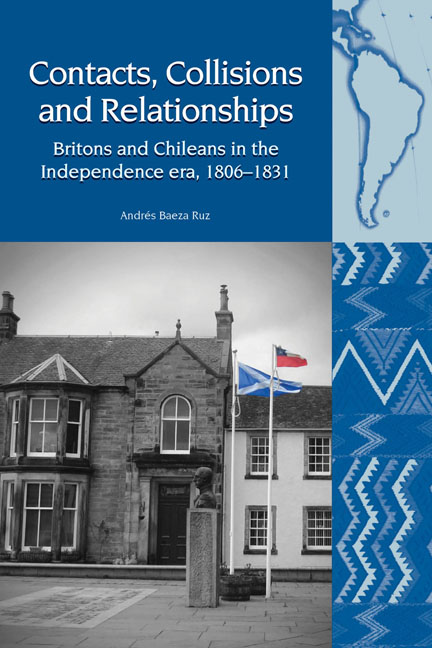Book contents
- Frontmatter
- Contents
- Acknowledgements
- Abbreviations
- Preface
- Introduction
- 1 Invasions, Negotiations and Conspiracies: British-Chilean Relations in an Era of Change, 1806–1817
- 2 Cultural Encounters Offshore: Britons and Chileans in the Chilean Navy, 1817–1823
- 3 Bibles, Schools and Citizens: British Protestant Missionaries and Educators in Chile, 1817–1831
- 4 British Merchants, Private Interests and the Fostering of Free Trade in Chile, 1811–1831
- 5 Beyond Diplomacy: The Cultural Significance of British Recognition of Chile's Independence, 1817–1831
- Conclusion
- Bibliography
- Index
4 - British Merchants, Private Interests and the Fostering of Free Trade in Chile, 1811–1831
- Frontmatter
- Contents
- Acknowledgements
- Abbreviations
- Preface
- Introduction
- 1 Invasions, Negotiations and Conspiracies: British-Chilean Relations in an Era of Change, 1806–1817
- 2 Cultural Encounters Offshore: Britons and Chileans in the Chilean Navy, 1817–1823
- 3 Bibles, Schools and Citizens: British Protestant Missionaries and Educators in Chile, 1817–1831
- 4 British Merchants, Private Interests and the Fostering of Free Trade in Chile, 1811–1831
- 5 Beyond Diplomacy: The Cultural Significance of British Recognition of Chile's Independence, 1817–1831
- Conclusion
- Bibliography
- Index
Summary
Introduction
The final case study to be discussed is the role of the other British ‘non-state’ actors involved in Chile's independence era: merchants. The presence of merchants and traders of different nationalities had been very extensive along the Chilean coasts prior to the crisis of 1808, but their presence was illegal since Spain had adopted a trade monopoly policy after its conquest of America. The situation changed after 1811 thanks to the policies adopted by the new Chilean authorities, who gradually ‘legalised’ the status of these ‘smugglers’. As a result, the activities of British merchants in Chile were no longer forbidden and their former status as illegal traders or smugglers shifted as they became legal merchants operating in Chile.
The role of merchants raises some interesting questions regarding the nature of the links between trade and British imperialism. It is difficult not to regard British merchants as agents of the British Empire, considering that trade was one of the main means of imperial expansion to the extent that Peggy K. Liss, a historian of the Atlantic empires, refers to imperial England as a ‘trading nation’. In a classic work on the relations between Latin America and Britain in the independence era, Charles Webster claimed that ‘what the British government and people were really seeking was not territory, but trade and bullion’. Webster's interpretation became the basis of one of the most widespread assumptions about British policy towards the Spanish American independence struggle, that Britain was simply trying to expand its commercial routes and markets to sell the goods it produced in the context of the Industrial Revolution. However, as discussed in the Introduction of this book, there is an ongoing debate about the extent to which the interests of merchants and businessmen are coincident with the interests of government.
As shown in Chapter 1, the plan to invade Chile in 1806 aimed to build up a trade route to connect the Atlantic and the Pacific with Chilean ports as key connection points. Even though the plan was outlined by the ‘official mind’, its actual aim was to open new trade routes for British merchants, who were not precisely agents of the state.
- Type
- Chapter
- Information
- Contacts, Collisions and RelationshipsBritons and Chileans in the Independence era, 1806-1831, pp. 153 - 184Publisher: Liverpool University PressPrint publication year: 2019

